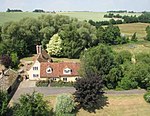Wixoe

Wixoe is a village and civil parish in the West Suffolk district of Suffolk in eastern England. Located on the northern bank of the River Stour, two miles south-east of Haverhill, in 2005 its population was 140. It consists largely of Victorian cottages along a narrow lane. There is a church of 12th-century origin, St Leonard's, much restored in the 1880s. It was recorded in the Domesday Book, at 600 acres one of the smallest parishes in the hundred of Risbridge. There are some 13 listed buildings, including a 19th-century bridge and a water mill.The Great Eastern Railway ran through the village, part of the Stour Valley line from 1865 until its closure in March 1967 under the Beeching 'axe'. The nearest stations were Sturmer to the west and Stoke-by-Clare to the east. The track bed and embankments remain clearly visible.
Excerpt from the Wikipedia article Wixoe (License: CC BY-SA 3.0, Authors, Images).Wixoe
Church Terrace, West Suffolk
Geographical coordinates (GPS) Address Nearby Places Show on map
Geographical coordinates (GPS)
| Latitude | Longitude |
|---|---|
| N 52.059 ° | E 0.504 ° |
Address
Church Terrace
CO10 8UJ West Suffolk
England, United Kingdom
Open on Google Maps





